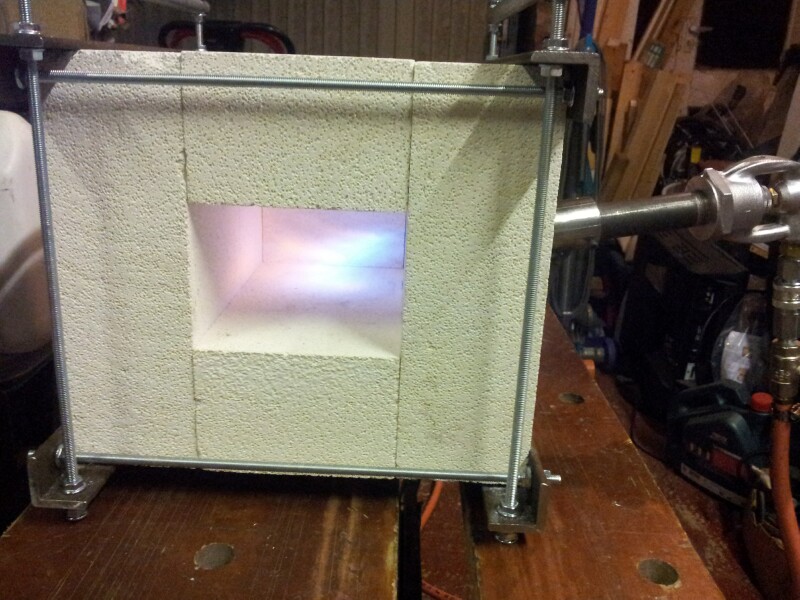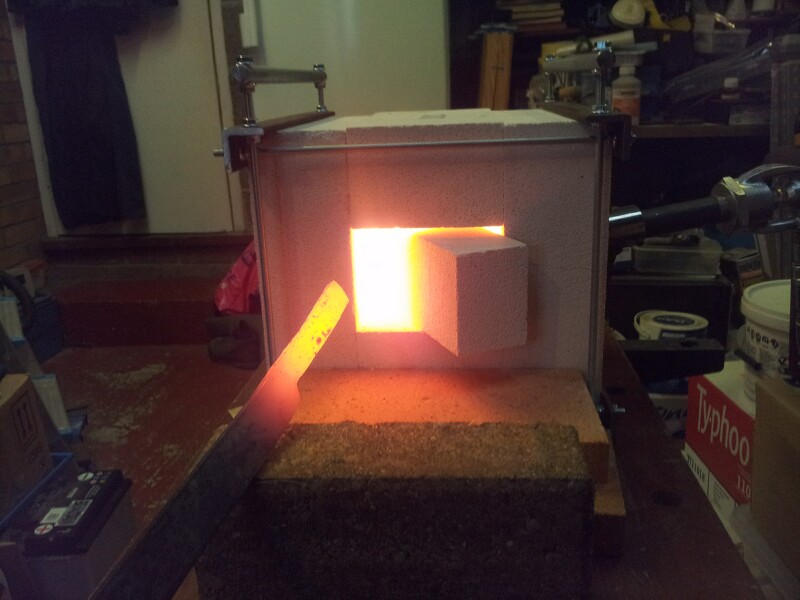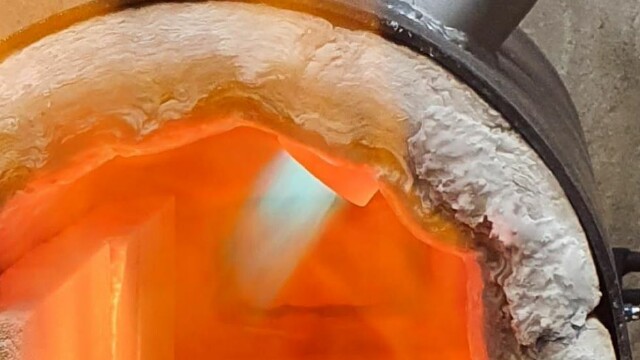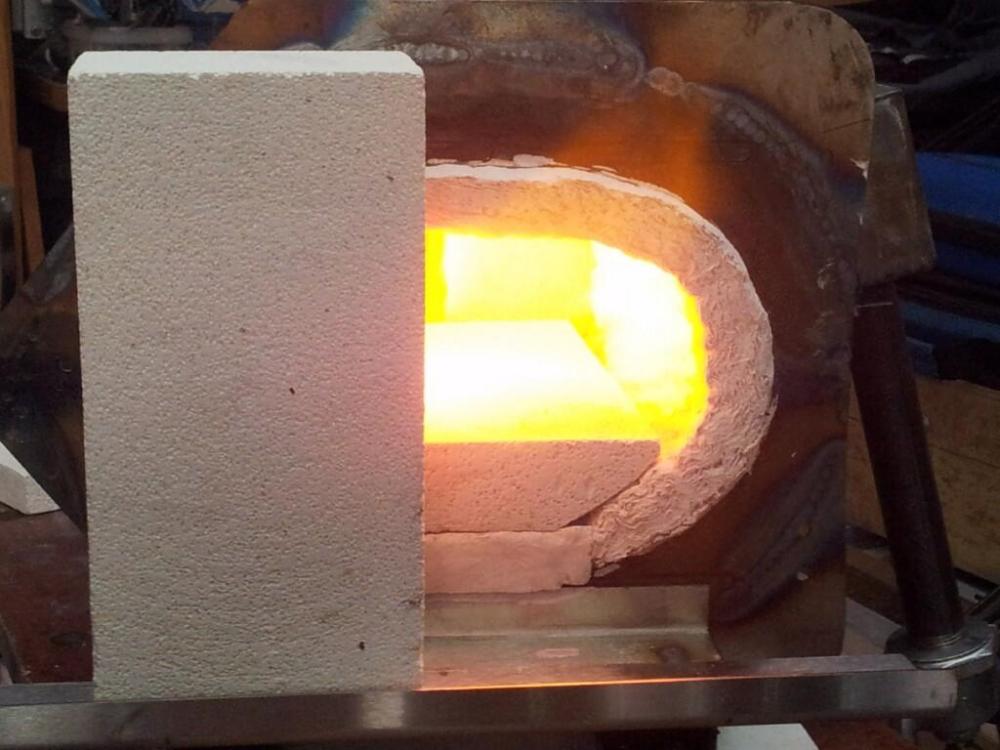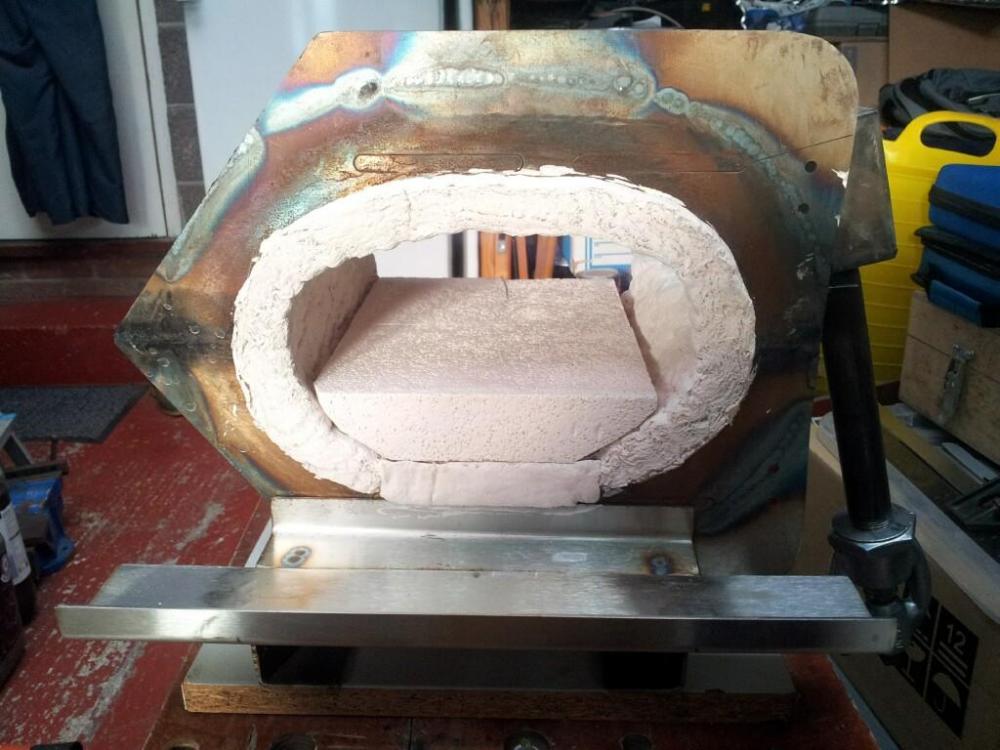-
Posts
143 -
Joined
-
Last visited
Content Type
Profiles
Forums
Articles
Gallery
Downloads
Events
Everything posted by tinkertim
-
Hi NoGood..., The Rigidizer I used was colloidal Silica powder mixed into water, with some food dye added, so you can see where you've sprayed. Once the blanket is coated you have to evaporate off the water by gentle heating with a hand-held burner. Once steam stops coming off the blanket, you are left with microscopic clumps of Silica particles at the points where the ceramic fibres in your blanket touch each other. Air-drying will not rigidise the blanket, it needs to be "fired", so you now want to heat the blanket to melt these clumps of Silica particles so they fuse your ceramic fibres together and give the rigidising effect you want. I manually moved my burner slowly over the whole inner surface of the blanket until every point had reached a dull orange at some point, and I then let it cool. It also helped that the areas that were heated fully then lost their food colour and went off-white. After this, you could touch the inner surface of the blanket and it felt stiff, and resisted light pressure. This is now a rigidised blanket, and ready for your refractory coating, etc. Hope this helps, Tink!
-
Yup. Mentioned ~7 posts earlier. Tink!
-
Have you been spritzing the rigidised ceramic blanket with water (buttering it), before you apply your KOL? If not, then the blanket will wick-away moisture from the KOL where it meets the blanket, leaving a dry and not-well-attached interface between the two materials. Hope this helps. Tink!
-
Hi Deimos, The angle-iron and threaded rods generally keep enough tension on the soft fire bricks, so that it will still hold together and be usable if it cracks. It is more the granular nature of the surface of the soft fire bricks that suffer most after heat/cool cycles. Filling this open surface with a protective "Flame Face" coating makes it tougher, and less likely to crumble with the high heat of forging. Be aware that all forge lining materials are "disposable" items, and will need to be replaced over time. The more expensive refractory coatings, such as Kast-o-lite30 have a much, much longer lifetime that Insulating Fire Bricks (IFBs), but a beginners forge made out of IFBs will allow you to learn a lot. If you cannot get Matrikote or Plistex easily in NL, then you could try the DIY flame-face mix I use. It works well on IFB's (which I have on the floor of my second forge design). I have to go for now, but will post up some more info later if you are interested. You could check out my posts in the "Problem with Forge. Welding Temps" thread if you like. Tink!
-
My first Insulating Fire Brick (IFB) forge was built with angle-iron and threaded rods, as it's one of the simplest designs for beginners. I fitted an angled side-mounted burner, rather than a top-mounted one, to avoid the burner pipework over-heating when the forge was turned off. If you block-off some of the end openings with spare IFB's, then the forge can get plenty hot enough for a beginner. Insulating Fire Bricks are easy to cut with an old saw (which will then be blunt!), and you can recess the end of your burner into the inner wall of an IFB, so that your burner tip doesn't melt. IFB's are fragile, and will crack after a number of heat/cool cycles. Coating the inner surface with a suitable "Flame Face" coating will make them last longer. I believe the recommended coatings are Matricote or Plistex, but I used a DIY mix, as it was easier to get the materials in the UK. Good luck with your build. Tink! Tink!
-
The problem for Miki will be getting Kast-o-lite30 in Ireland. Seems easy in the USA, but is not easy in the UK. That is why I went with the Zircopax/Colloidal-Silica slurry coating. Easy to get hold of in the UK, efficient on gas, easy to patch. Ticks my boxes for a hobbyist. Tink!
-
Hi Miki, The rules of this Forum don't allow direct links to products on commercial websites, so you might get a warning about your link above. (And I might for quoting your link!) Your link is to the wrong stuff. If you looked at the top of page 2 of the link I attached in my previous reply, you will have seen the Google searches needed to find the Zircopax and Colloidal Silica solution you need, to do the flame-face coating I've used. GOOGLE: scarva en gb zircopax GOOGLE: ulster ceramics morisol x30 Read all 3 pages of the link I sent you, as there is important information about how to mix & apply the coating, and only mix as much as you need, in a disposable cup, as the Zircopax will harden at the bottom if left. Tink!
-
Well just scratch Made-in-China on the side and ship-away!
-
Well I finally used some Cobalt Steel drill bits for the first time at the weekend, to drill out and re-tap a bolt on a wheel hub that holds the Anti-Lock Brake sensor in place on a Mazda (Miata?) MX5. All my HSS drill bits stopped cutting after ~20 seconds and I was getting worried that it wouldn't be back on the road for Monday. Found my local Screwfix stocked a few sizes of Dewalt Cobalt Steel drill bits. Expensive, but the reviews suggested they would work when nothing else would. Gave them a try and they were excellent! Stayed sharp all the way through! You do need to regularly stop and re-lube the hole, and don't use excessive speed or pressure, but they really got me out of (or into) a hole. They are my get-out-of-jail drill bits now. I'm keeping them for the special occasions, and will definitely be buying more. Hope this helps. Tink!
-
Wow Frank! That almost looks like a spacecraft engine! (Millenium Falcon / Nostromo!) That is so cool. Me likey a lot! I'd still be interested in one of your 1/4" vortex injectors to use as a hand-held burner. Please let me know when they are available. Keep up the fantastic work, matey. Tink!
-
Hi Miki, Two things. One is the metal flares at the end of your burners. As you can see from the zoomed-in picture you posted, your flare is glowing at the same temperature as the inside of your forge. If you do get your forge to run hotter, you will melt the flare! As the flare is there to give a region where the Fuel/Air Mix (FAM) slows down and burns, many people form this flare shape in the insulating lining of their forge, which can take the higher temperatures. The other is, as others have said, you need to coat the rigidised Ceramic fiber blanket to make a safer and more robust "Flame face" for your forge. There are typically two choices in the types of Flame face you can use, but the availability in your Country can affect which one you go for. First choice: In the USA the preferred/recommended coating is called Kast-o-lite 30, which is a High-Alumina water-setting refractory coating that contains bubbles of Alumina to make it highly insulating, while being very tough and resistant to the fluxes you might use to assist in forge-welding. You would buy a sack, mix it up like a concrete, and apply it in a layer of a half to 3/4 of an inch all over the inside of your forge and wait for it to set. It sounds epic stuff, but is not easy to find in "affordable" volumes for a hobbyist in the UK (~£240 for a 25kg bag delivered). I know, I looked for Months. Second choice: Having read the complete Forges-101 and Burners-101 threads (yes it takes ages, but there is so much invaluable information from very experienced people, it would almost be crazy not to) I came across an alternative Flame face coating method. A forum member called D.Rotblatt had been doing slipcasting of metals, and had been making and using a high-temperature slurry to coat the inside of his ceramic blanket for decades. Unlike Kast-o-lite, which sets to a rigid, concrete-like finish, this slurry is mixed up in a pot and painted on over the rigidised blanket and then heated to set. You need to paint and set a good few layers to build up a protective crust of Flame face. This slurry is a mix of Zircopax(Zirconium Silicate powder) and a Colloidial Silica liquid. When it dries and is heated, the Zircopax acts like an Infra-Red re-emitter, and radiates heat back into your forge. It is not as strong a coating as Kast-o-lite30, but it heats up very fast (so is cheaper on gas), is easy to patch, will protect the surface of ceramic blanket and soft fire bricks (which are damaged over time with too much direct flame impact), and it is pretty cheap. Ideal for a hobbyist! Here's a link to a thread where I built a forge and used and tested this Zircopax slurry with great success. Scroll through the thread for more info. As you have used soft fire bricks and ceramic blanket as I have, you might find it effective. Also as some of the materials I ordered were from Ulster, you might get them even cheaper where you are. Sorry for the long post, but hope this helps. If you have any questions about the Zirconium slurry coating option please drop me a line. All the best with getting happy with forging. As others have said, forge-welding is an advanced skill, so don't try it as a first training job, as other things have to be sorted before you have the right environment to even start trying. I love your Halloween Pumpkin model. it is really cool, and shows you are already on the right track. That and your fabricating skills (a beautifully constructed, if a little large, forge) means you should have no trouble getting there. Also, a good place for practice steel is Automotive Servicing places. All those broken coil springs from car/van suspensions are great steel to practice on, as they will be a spring steel, so will contain carbon, so will be hardenable if you wish to make tools or knives. Also I believe carbon steel is easier to forge-weld than mild steel, for when you eventually get there. I've just walked into the garages and asked the mechanics if they have any broken springs to practice blacksmithing on. They usually say help yourself. Cheers, Tink!
-
Hi Mikishelby, Welcome to IFI. I'm guessing you are in the UK, from the Calor gas cylinder and the Vitcas box from the first picture. Add your location to your profile, so other members can see where you are based, as it can make a difference to what materials are available in which countries, and what advice you might be given. Also you might find other members nearby that you can meet up with ( Covid-permitting of course!) I also noticed that your flares, at the exit of your burners, appear to be protruding into your forge. Normally you try and position your flares so that they are recessed into the ceramic wool insulation, as they will burn-up/melt in their current position as you manage to raise the temperatures in your forge. I'm very jealous of your workshop! If only I had that much space to devote to tinkering! Keep us posted with your progress. All the best, Tinker Tim
-

Naturally Aspirated Ribbon Burner. Photo heavy.
tinkertim replied to Frosty's topic in Ribbon Burners
Amalcarb.co.uk say they will export to the USA, but there is no mention of distributors outside the UK. Could you just order one directly from them? -
The originator of the lightweight Zircopax/Silica slurry coating is Dan Rotblatt, who has been using this coating successfully for decades. I followed his advice and have built an efficient hobbyist forge that heats up fast and uses minimal gas. The coating won't survive heavy bashing, but it is easy to patch/recoat if you do dink it. I'll certainly be using this coating technique on future forges. Hope this helps. Tink!
-
Hi Bliziak, and welcome to the site. From the looks of things, with the angle of the torch port in your Bean-can forge, when you place the torch in the port, does your MAPP can sit horizontally? If it does, then I think the reason for your billowing yellow flames is because the exit port on your MAPP tank will be below the level of liquid MAPP, so you will be spraying out liquid MAPP instead of gas MAPP! I've done the same with weed burners, where I've turned the gas cylinder upside-down for a moment and the liquid gas has momentarily sprayed out like a big yellow flame thrower! Does your MAPP burner behave itself when the cylinder is vertical, outside the forge? Also there are various approaches to building a forge, based on what you want to do, be a hobbyist or professional, and what materials you can get hold of. One of the main issues when starting out is using materials that can take the heat but are also insulating. This is very important. There seem to be a large number of new smiths who have built their forge using high temperature NON-insulating heavy fire bricks, who arrive here and ask why their forge cannot reach a useful temperature, or why it empties a gas tank in minutes. The simplest thing to start out with is a few Insulating Fire Bricks (IFBs). These are very light (and fairly fragile) but are very good insulators, are easy to cut and drill, and can just be clamped together with pieces of angle-iron and threaded rod, to form a very effective forge. IFBs are not very long lasting when in direct flame contact, but a coating like Plistex will give some protection and increase the life of an IFB forge. Here is a link to my first IFB forge: Once you decide to make your next forge (you will, we can't help ourselves!), the recommended method is to line a steel cylinder with 2 layers of 1 inch thick high temperature ceramic blanket (2 x 1inch layers is easier to form into a cylinder without creasing, than a single 2inch thick blanket is). Don't build an enormous 2 foot long forge that you could fit a boat anchor into, as it will drink gas, and wont work well for 95% of the typical jobs you want to do. For making knives and blades, etc. you typically don't want to heat more that 6 inches of your metal to forging temperature, as that is pretty much all you can work in a single heat. Repeatedly overheating all your steel is a recipe for burning out the carbon in the outer layer of your steel and ruining it. Calculate the inner volume of your forge before you start to build it, to ensure your burner can bring it to the working temperature you want. A typical calculation used on here is an efficient and well tuned 3/4 inch propane burner will bring a forge with an internal volume of ~350 cubic inches easily up to forge-welding temperatures. There are tables for other burner sizes and volumes in the Forges-101 and Burners-101 threads. You will want to rigidise the ceramic blanket after installation. You can but ready-mixed rigidiser, or you can by Fumed/Colloidal Silica powder online (often used as a thickener with fiberglass resins), and mix some with water and a drop of food dye in a hand spray bottle. Shake well and spray all over the inside surface of your ceramic blanket (the food colouring ensures you don't miss a spot). Then with a gas torch gradually heat up the inside of the forge to drive off the water as steam. Keep the torch moving all over the surface, until the water has evaporated, and continue until the surface of the blanket starts to glow a dull orange. Keep the torch moving until you have had a dull orange glow over every part of the surface (you don't need to get the whole surface glowing orange at the same time at this stage). Then allow to cool. Once cold, you should be able to lightly press your finger against the surface of the blanket and feel that it is now stiff and rigidised. Next is the flame face. If you can get it, the best insulating refractory coating you can buy seems to be Kastolite30. It seems to be easy to get in the States, but not so easy in Europe or the UK. A 1/2 to 3/4 inch layer of Kastolite30 seems to be the preferred thickness, and gives you a very tough and pretty good insulating flame face for your forge. You can add a kiln wash such as Plistex to increase the efficiency I believe. I have to say I would have gone down the Kastolite30 route if it was easy for me to find in the UK. As it wasn't, I tried an alternative coating approach as suggested by D.Rotblatt on this site. He has been metal casting for decades, and has been using a casting slurry mix for coating his rigidised ceramic blanket, and has been getting good results. The coating is not as tough as Kastolite30, but it is very easy to patch or recoat any dinks in the blanket, and it heats up very fast, which makes it more efficient and less of a gas hog, which as a hobby smith is what I was looking for. His coating really works well for me. You can find more info about how I got on in this thread: Sorry for the long post, I just got into a flow. Anyway, good luck with your forge building. Read through the Forges-101 and Burners-101 threads. They are very long but are packed with invaluable real-world advice about what really works. If you read these threads and then ask questions, people will know you have a good head-start. Cheers, Tink!
-

Water not sticking to ceramic fibers when ridgidizing
tinkertim replied to Fredvårek's topic in Insulation and Refractories
I bet if it's for insulating pipes that it has some kind of water-repellent properties, as you wouldn't want a leaking pipe to completely fill the insulation layer with water, especially as it has a metal foil backing. You might get the insulation so heavy with water that it pulls itself off the pipes. Not ideal. Just a thought. Good luck. Tink! -

3D printed plastic burner experiments (photo heavy)
tinkertim replied to Another FrankenBurner's topic in Gas Forges
That is just EPIC AFB!!! It seems from my perspective that not only are you developing some of the coolest(NOT!) burners and forges out there but it seems that you are having great fun while you are doing it! I am in awe! Keep having fun my friend. Tink!- 863 replies
-

3D printed plastic burner experiments (photo heavy)
tinkertim replied to Another FrankenBurner's topic in Gas Forges
Cheers for the info AFB. Tinkering? It is literally the story of my life! I might have a look at FreeCAD, but I guess as I'm pretty skilled with the Designspark Mech tool (we also use it for pulling in PCB designs to ensure they fit inside custom cases, etc.) I think I'll continue to play with the "clunky" I know rather than learn a new clunky. I'm thinking of making an approximation of your 3/8" burner to use as a hand-held torch, and may design a simple pistol-grip into it, purely for some lock-down activity, and because its tiring trying to dial a 3/4" AMAL burner low enough to use as a paint stripper on a steel garage door without going through the door! Cheers matey. Tink!- 863 replies
-

3D printed plastic burner experiments (photo heavy)
tinkertim replied to Another FrankenBurner's topic in Gas Forges
Hey AFB, That is a cracking micro-burner! Very impressive. I've been meaning to ask you which CAD software you use for your 3D printed injectors. I've been using a free one called Designspark Mechanical for many years. It is a cut-down version of a powerful package that RadioSpares (RS) sponsored and offered as truly free tool, but with the option of using free 3D libraries of the parts they sell on their website. I've used it a lot for various 3D printed parts, as well as designing the re-layout of stud-walls in a utility room. The reason I'm asking about what you use, is that I was trying to work out how I would go about designing the twisting vanes for an injector without having to do lots of "lofting" to allow the vane profile to twist correctly. I wondered whether other free tools would be better at it. Keep up the great work! Tink!- 863 replies
-
Hi Panik, Have a look at this thread. There is a member called D.Rotblatt (Dan) who has been using a type of slip casting as a coating for his forges for the last 20 years very sucessfully. After a long chat with him in this thread, I followed his suggestions and used a Zircopax/Colloidial Silica slurry to coat the interior of my 2-inch ceramic-fiber-lined forge, and found it worked very well for me. It might not be as tough as a hard castable refractory, but it heats up much faster than one, is easy to patch with more slurry if you bash it, and seems to be very economical on Propane for a DIY smith like me, and gets really hot with my Naturally Aspirated Ribbon Burner (NARB) pictured below. Hope this helps, Tink!
-

3D printed plastic burner experiments (photo heavy)
tinkertim replied to Another FrankenBurner's topic in Gas Forges
AFB I really like where you are going with these mini-Forge designs. Elegent and functions design. Keep up the good work. Tink!- 863 replies
-

3D printed plastic burner experiments (photo heavy)
tinkertim replied to Another FrankenBurner's topic in Gas Forges
AFB that is a cracking little Forge!! and the efficiency ticks all my boxes as a hobbyist Smith. Pnut is totally right. If you could simplify the construction to save yourself assembly time it would be a very sellable product. If not, your proven efficient burner design has customers waiting already (me for one!) Keep up the good work and have a cracking New Year matey! Tink!- 863 replies
-
Hi NS, The burner is a single 3/4" AMAL gas injector with 8 inches of black iron pipe feeding into the Plenum chamber of my DIY Ribbon Burner. The Burner is normally aspirated with 27 x 5.5mm holes drilled into the Insulating Fire Brick (IFB) that makes up the burner face. As a hobbyist I wanted a Propane forge that was quick to heat up and economical to use. I decided to try the technique suggested by Dan Rotblatt, so instead of using a cast refractory lining inside the forge, I used a Zirconium Silicate / Colloidal Silica slurry to coat the rigidised ceramic wool. This forms a layer only a few mm thick on top of the wool, which is then hardened by the Ribbon burner. It gives me a lining that is not as strong as a cast refractory, but is easy to patch if I do crack it, but crucially has very low thermal mass. I didn't want a forge to use all day, every day, but one I could turn on and off whenever I wanted to do some metal bashing. So to answer your question, it was up to welding temp in about 5 mins, and is very responsive to turning the gas up & down between bashings. I will probably sort out an Idle Bypass circuit at some stage, to make it more economical and easier to turn down between heats. Anyway I hope this helps. Tink!
-
I like the flexibility of reducing the volume of the forge to save fuel, or to let it get hotter for forge welding. This looks plenty hot enough! Good luck, Tink!
-
Hi North State, Do you mean something like this? This worked well for me. I used Insulating Fire Brick (IFB) and coated it with a Colloidal Silica/Zircopax slurry to give the IFB surface some protection. It worked really well for me. Tink!

